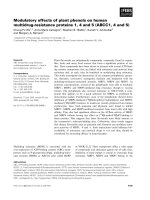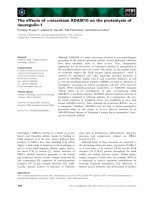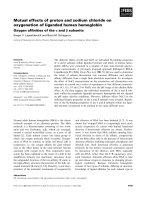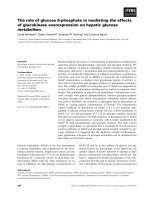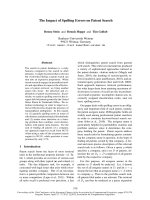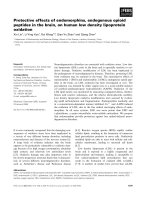Báo cáo khoa học: " The effects of ectomycorrhizal status on carbon dioxide assimilation capacity, water-use efficiency and response to transplanting in seedlings of Pseudotsuga menziesii (Mirb) Franco" docx
Bạn đang xem bản rút gọn của tài liệu. Xem và tải ngay bản đầy đủ của tài liệu tại đây (704.56 KB, 13 trang )
Original
article
The
effects
of
ectomycorrhizal
status
on
carbon
dioxide
assimilation
capacity,
water-use
efficiency
and
response
to
transplanting
in
seedlings
of
Pseudotsuga menziesii
(Mirb)
Franco
JM
Guehl
J
Garbaye
1
INRA
Centre
de
Recherches
de
Nancy,
Laboratoire
de
Bioclimatologie
et
d’Écophysiologie
Forestières,
54280
Champenoux;
2
INRA
Centre
de
Recherches
de
Nancy,
Laboratoire
de
Microbiologie
Forestière,
F
54280
Champenoux,
France
(Received
30
March
1990;
accepted
5
December
1990)
Summary —
One
year-old
Douglas
fir
seedlings,
mycorrhizal
with
Laccaria
laccata
or
with
Thele-
phora
terrestris
and
grown
at
two
levels
of
phosphorus
in
the
nutrient
solution
(10
and
40
mg·l
-1
P),
were
compared
for
water
relations
and
gas
exchange
before
and
after
transplanting
in
non-limiting
water
conditions.
The
results
show
that i),
L
laccata
is
more
efficient
than
T
terrestris
in
increasing
photosynthesis
and
water
use
efficiency,
ii),
phosphorus
deficiency
reduces
photosynthesis
and
wa-
ter
use
efficiency,
iii),
the
stimulating
effect
of
L
laccata
on
photosynthesis
and
water
use
efficiency
is,
at
least
partly,
due
to
the
improvement
of
phosphorus
nutrition,
iv),
the
photosynthesis
reduction
resulting
from
transplanting
is
due
to
a
non-stomatal
mechanism,
and
v),
the
recovery
of
photosyn-
thesis
involves
the
regrowth
of
the
external
mycelium
of
mycorrhizas.
These
results
are
discussed
from
the
viewpoint
of
the
plant-fungus
relationships.
ectomycorrhizae
/
phosphorus
nutrition
/
CO
2
assimilation
/
water-use
efficiency
/
transplant-
ing
Résumé —
Effets
du
statut
mycorhizien
sur
la
capacité
d’assimilation
de
CO
2,
l’efficience
d’utilisation
de
l’eau
et
la
réponse
à
la
transplantation
de
semis
de
Pseudotsuga
menziesii
(Mirb)
Franco.
Des
semis
de
1
an
de
douglas,
mycorhizés
par
Laccaria
laccata
ou
Thelephora
ter-
restris
ont
été
élevés
durant
une
saison
de
croissance
à 2
niveaux
de
phosphore
dans
la
solution
nutritive
(10
et
40
mg·l
-1
P)
et
ont
été
comparés
du
point
de
vue
des
relations
hydriques
et
des
échanges
gazeux
avant
et
après
transplantation
(à
2
dates
différentes,
en
octobre
et
en
février)
en
conditions
hydriques
non
limitantes.
A
faible
niveau
de
phosphore,
les
plants
inoculés
par
L
laccata
avaient
une
surface
foliaire
plus
importante
que
les
plants
mycorhizés
par
T
terrestris
(tableau
1) et
étaient
également
caractérisés
par
des
taux
d’assimilation
de
CO
2
et
d’efficience
photosynthétique
d’utilisation
de
l’eau
plus
élevés
(tableau
II
et
fig
1).
La
carence
en
phosphore
réduit
la
photosyn-
thèse
et
l’efficience
d’utilisation
de
l’eau
(tableau
II,
fig
1).
L’effet
stimulant
de
L
laccata
sur
l’effi-
cience
de
l’eau
est
dû,
au
moins
en
partie,
à
l’amélioration
de
la
nutrition
en
phosphore
(fig
7
et
9).
La
réduction
de
la
photosynthèse
consécutive
à la
transplantation
(fig
2),
bien
qu’accompagnée
par
une
fermeture
stomatique
(fig
3),
est
dûe
essentiellement
à
un
mécanisme
non
stomatique
(fig 4)
et
n’est
pas
liée
à
une
altération
de
l’état
hydrique
et
nutritionel
(fig
7
et 8)
des
plants.
Le
rétablissement
de
la
photosynthèse
après
transplantation
est
concomitant
à
la
régénération
racinaire
(fig
5),
mais
son
déterminisme
implique
également
la
reprise
d’activité
du
champignon
(fig
6).
Ces
résultats
sont
discu-
tés
du point de
vue
des
relations
plante-champignon.
ectomycorhize
/
nutrition
phosphatée
/
assimulation
de
CO
2
/
efficience
de
l’eau
/
transplanta-
tion
INTRODUCTION
Ectomycorrhizal
symbiosis
is
essential
for
nursery-grown
conifer
seedlings
and
is
de-
terminant
for
plant
survival
and
growth
af-
ter
outplanting
(Marx
et
al,
1977;
Le
Tacon
et
al,
1988).
It
is
also
known
that
different
fungal
associates
do
not
provide
the
same
benefit
in
this
respect,
through
mecha-
nisms
as
diverse
as
improving
mineral
ab-
sorption
and
assimilation
affecting
hormo-
nal
balance
in
the
plant,
enhancing
the
contact
between
roots
and
soil,
and
pro-
tecting
roots
against
disease
(Chalot
et
al,
1988).
This
paper
describes
and
discuss-
es
the
physiological
status
of
one
year-old
Douglas
fir
seedlings,
associated
with
two
different
ectomycorrhizal
fungi
and
grown
at
two
phosphorous
levels,
before
they
were
lifted.
The
behaviour
of
the
same
seedlings
transplanted
in
controlled
condi-
tions
was
also
considered.
The
results
presented
here
are
part
of
a
project
which
is
aimed
at
understanding
the
role
played
by
the
fungal
associates
during
the
transplanting
shock
suffered
by
forest
plants
when
outplanted,
even
in
non-limited
water
supply
conditions
(Guehl
et
al,
1989).
Gas
exchange
parameters
(CO
2
assimilation
rate,
transpiration
rate,
water-use
efficiency)
were
used
as
physio-
logical
criteria
for
monitoring
the
behaviour
of
plants
with
different
ectomycorrhizal
status.
MATERIALS
AND
METHODS
Plant
material
Douglas
fir
(Pseudotsuga
menziesii
(Mirb)
Fran-
co)
seedlings
were
grown
in
the
summer
in
a
glasshouse,
in
95
ml
containers
filled
with
1/1
(v/
v)
vermiculite-sphagnum
peat
mix
inoculated
with
the
ectomycorrhizal
fungus
Laccaria
lacca-
ta
or
non-inoculated.
Inoculum
was
mycelium
aseptically
grown
for
two
months
in
glass
jars,
in
a
vermiculite-peat
substrate
moistened
with
nu-
trient
medium.
Twenty
per
cent
(v/v)
inoculum
was
mixed
with
the
potting
mix
before
filling
the
containers.
Each
inoculation
treatment
was
wa-
tered
with
a
complete
nutrient
solution
contain-
ing
either
10
or
40
mg·ml
-1
phosphorus
as
Na
2
PO
4.
Each
fungus-phosphorus
level
treat-
ment
involved
120
seedlings.
At
the
end
of
Sep-
tember,
when
growth
stopped
and
buds
were
set
up,
a
random
sample
of
6
seedlings
per
treatment
was
observed
for
mycorrhizas
with
a
stereomicroscope
after
gently
washing
the
root
systems.
Ectomycorrhizal
development
was
rat-
ed
according
to
a
four-level
scale
(0:
no
mycor-
rhiza;
1:
rare
mycorrhizas;
2:
several
conspicu-
ous
mycorrhizal
clusters
and/or
mycorrhizas
disseminated
throughout
the
root
system;
3:
my-
corrhizas
abundant
in
all
parts
of
the
root
sys-
tem).
Three
treatments
were
chosen
for
subse-
quent
measurements
and
analysis:
-
Tt
low
phosphorus
level,
non
inoculated,
my-
corrhizal
with
contaminant
Thelephora
terrestris
(mycorrhizal
rating:
1.6);
-TtP:
high
phosphorus
level,
non-inoculated,
mycorrhizal
with
T terrestris
(rating:
2.4);
]
-
LI:
low
phosphorus
level,
inoculated
with
Lac-
caria
laccata,
predominantly
mycorrhizal
with
L
laccata
(rating:
2.6)
and
slightly
contaminated
with
T terrestris.
Sampling
and
experimental
set-up
The
seedlings
were
kept
in
a
frostless
glass-
house
during
winter,
without
fertilization,
under
conditions
such
that
aerial
growth
was
stopped
from
October
to
March.
Two
sets
of
measure-
ments
were
performed:
in
November
and
in
Feb-
ruary.
At
each
date,
20
plants
per
treatment
were
randomly
picked
among
the
50%
tallest
ones.
Before
transplanting,
6-8
of
these
plants
were
used
for
gas
exchange
measurements
and
for
determining
the
phosphorus
and
nitrogen
content
of
the
needles.
The
12
remaining
plants
were
used
for
gas
exchange
measurements
and
transplanted
as
follows:
they
were
immediately
lifted,
their
roots
washed,
and
mycorrhizal
devel-
opment
was
quantified.
The
growing
white
root
tips
were
sectioned,
and
the
seedlings
were
planted
in
sphagnum
peat
in
flat
(3
cm
thick)
containers
with
a
transparent
wall
allowing
ob-
servation
of
the
roots.
These
containers
were
placed
in
a
climate
chamber
under
the
following
environmental
conditions:
photoperiod,
16
h;
air
temperature,
22
±
0.2°C
(d)
and
16.0
±
0.2°C
(night);
photosynthetic
photon
flux
density (400-
700
nm),
400
μmol
m
-2
s
-1
provided
by
fluores-
cent
tubes;
relative
air
humidity,
60%
(day)
and
90%
(night);
ambient
CO
2
concentration
(C
a
),
420
±
30
μmol·mol
-1
.
They
were
watered
twice
a
week
with
the
10
mg·l
-1
P
nutrient
solution
in
order
to
maintain
the
moisture
of
the
peat
near
field
capacity.
Water
status,
gas
exchange,
root
regenera-
tion
(number
of
elongated
white
tips),
and
re-
growth
of
mycorrhizal
extramatical
mycelium
(quantified
according
to
the
same
rating
scale
as
above)
were
assessed
4,
11
and
18
d after
transplanting.
At
the
end
of
each
experiment,
the
seedlings
were
processed
for
dry
weight
and
leaf
area
de-
termination.
Needles
were
then
oven-dried
(60°C
for
48
h)
and
mineral
analyses
were
per-
formed
(February
only).
Water
status
and
gas
exchange
measurements
Predawn
needle
water
potential
(ψ
wp
)
was
deter-
mined
on
one
needle
per
seedling
prior
to
the
gas
exchange
measurements
by
means
of
a
Scholander
pressure
bomb
specifically
devised
for
measurements
on
individual
conifer
needles.
For
the
November
experiment,
the
plants
were
taken
from
the
climate
room
to
a
laborato-
ry
where
gas
exchange
measurements
were
made
by
means
of
an
open
system
consisting
of
three
assimilation
chambers
connected
in
paral-
lel
in
which
the
environmental
factors
could
be
controlled.
Measurements
were
made
at
22.0
±
0.5°C
air
temperature,
10.6
±
1.0
Pa·kPa
-1
leaf-
to-air
water
vapour
molar
fraction
difference,
400
μmol·m
-2·s-1
photosynthetic
photon
flux
density
(400-700
nm)
and 350
±
5
μmol·mol
-1
ambient
CO
2
concentration
(C
a
).
For
the
February
experiment,
gas
exchange
measurements
were
made
in
the
climate
room
with
a
portable
gas-exchange
measurement
sys-
tem
(Li-Cor
6200,
Li-Cor,
Lincoln,
NE,
USA).
The
CO
2
concentration
in
the
climate
room
was
kept
constant
(C
a
=
425
±
15
μmol·mol
-1).
Gas
exchange
parameters
(CO
2
assimilation
rate,
A;
leaf
conductance
for
water
vapour,
g;
in-
tercellular
CO
2
concentration,
Ci)
were
calculat-
ed
with
the
classical
equations
(Caemmerer
and
Farquhar,
1981)
taking
into
account
simultane-
ous
CO
2
and
H2O
diffusion
through
the
stomatal
pores.
Intercellular
CO
2
concentration
(C
i)
calcu-
lations
were
performed
in
order
to
assess
whether
differences
for A
between
treatments
and
A
changes
in
response
to
transplanting
were
due
to
chloroplastic
or
to
stomatal
factors
(Jones,
1985).
Previous
measurements
made
on
conifers
(unpublished
data)
did
not
show
any
patch
pattern
in
stomatal
closure,
so
that
relia-
ble
Ci
calculations
can
be
performed
from
leaf
gas
exchange
data.
More
precisely,
CO
2
assimi-
lation
rate
was
considered
in
an
(A,
Ci)
graph
as
being
at
the
intersection of
two
functions:
i),
the
photosynthetic
CO
2
demand
function
(D)
which
defines
the
mesophyll
photosynthetic
capacity
and,
ii),
the
photosynthetic
CO
2
supply
function
(Su)
defining
the
diffusional
limitation
to
CO
2
as-
similation.
For
determining
the
(D)
functions,
Ca
was
varied
stepwise
and
A
and
Ci
were
calculat-
ed
for
each
step.
The
Su
function
is
a
line
with
an
x-axis
intercept
approximately
equal
to
Ca
and
a
negative
slope
approximately
equal
to
-g
(Guehl
and
Aussenac,
1987).
Water-use
effi-
ciency
(WUE)
was
determined
as
the
A/g
ratio.
At
the
end
of
the
experiment,
the
seedlings
were
harvested
and
plant
material
was
separat-
ed
into
different
compartments
(needles,
stems
and
root
systems).
Each
compartment
was
oven-dried
at
60°C
for
48
h
and
weighed.
The
dried
needles
were
kept
for
mineral
analysis.
Projected
needle
areas
of
the
seedlings
were
determined
with
a
video
camera
coupled
to
an
image
analyser
(ΔT area
meter;
ΔT devic-
es,
Cambridge,
UK).
Mineral
analyses
The
total
nitrogen
content
of
the
dried
and
ground
needles
was
determined
with
a
C/N
analyser
(Model
1500;
Carlo
Erba,
Italy).
The
values
obtained
with
this
technique
are
about
10%
higher
than
those
obtained
with
the
Kjel-
dahl
method.
The
phosphorus
concentrations
were
determined
after
pressure
digestion
of
the
ground
material
with
100%
HNO
3,
at
170°C
for
6
h
(Schramel
et
al,
1980)
with
a
direct
current
plasma
emission
spectrometer
(Model
Spectro
Span
6;
Beckman
Instruments,
USA).
RESULTS
Plant
size
and
biomass
Data
relative
to
the
size
and
biomass
of
the
February
seedlings
(before
transplant-
ing)
are
given
in
table
I.
Stem
height
was
highest
in
the
TtP
and
LI
treatments.
Root
collar
diameter
and
total
dry
weight
were
significantly
higher
in
TtP than
in
the
other
treatments,
whereas
there
was
no
signifi-
cant
difference
in
the
root/shoot
ratio
be-
tween
the
different
treatments.
Needle
area
was
significantly
higher
in
TtP
and
LI
than
in
Tt.
The
seedlings
of
the
different
treatments
did
not
exhibit
significant
differ-
ences
in
their
specific
leaf
dry
weight
(ratio
of
needle
dry
weight
to
needle
area).
Gas
exchange
and
water-use
efficiency
Table
II
gives
the
mean
values
of
CO
2
as-
similation
rate
(A),
stomatal
conductance
(g)
and
water-use
efficiency
(WUE
=
A/g)
in
the
different
treatments
before
trans-
planting,
in
the
2
experiments.
TtP
and
LI
exhibited
A
values
significantly
higher
than
those
in
Tt both
in
November
and
in
Febru-
ary.
A
was
higher
in
TtP
than
in
LI
in
No-
vember
but
not
in
February.
In
November,
TtP
was
characterized
by
g
values
signifi-
cantly
higher
than
those
in
the other
treat-
ments,
while
in
February
there
was
no
sig-
nificant
difference
for
this
parameter.
Water-use
efficiency
in
TtP
and
LI
was
significantly
higher
than
that
in
Tt
in
both
experiments.
There
was
no
significant
dif-
ferences
between
TtP
and
LI.
For
a
given
treatment,
the
WUE
values
were
identical
for
the
two
experiments.
Figure
1
gives
an
insight
into
the
WUE
regulation
at
the
individual
level
prior
to
transplanting.
The
regression
lines
were
forced
through
the
origin
so
that
their
slopes
(water-use
efficiency)
could
be
compared.
In
November
as
well
as
in
Feb-
ruary,
the
invididual
variability
of
the
plots
relative
to
treatments
TtP
and
LI
was
or-
dered
along
the
same
linear
relationship
expressing
proportionality
between
A
and
g
and
thus
constancy
of
WUE
both
for
the
individual
plants
and
the
two
dates.
In
con-
trast,
treatment
Tt
did
not
exhibit
such
a
control
of
WUE
at
the
individual
level
since
no
significant
(P
<
0.05)
correlation
be-
tween A
and
g
was
observed
for
this
treat-
ment.
Moreover,
the
plots
of
the
latter
treatment
occupied
a
lower
position
in
the
(A,
g)
graphs,
thus
indicating
lower
WUE.
Transplanting
resulted
in
a
marked
de-
crease
of A
between
day
0
and
day
4
in
all
treatments
and
for
the
2
measurement
pe-
riods
(fig
2).
In
February,
the
decrease
of A
continued
until
18
d
after
transplanting
for
treatment
LI,
while
a
slight
recovery
of A
was
observed
from
d
4
in
treatments
Tt
and
TtP.
Such
a
recovery
was
not
appar-
ent
in
November,
when
the
decrease
in
A
was
more
pronounced
in
the
TtP seedlings
than
it
was
in
the
LI
seedlings,
since
the A
values
of
these
treatments
were
signifi-
cantly
different
at
day
0,
but
were
not
dif-
ferent
18
d
after
transplanting
(fig
2).
In
February,
a
very
different
pattern
was
ob-
served
with
the
decrease
of
A
being
the
most
pronounced
in
LI.
Transplanting
also
affected
g
(fig
3)
in
a
manner
approximately
identical
with
the
ef-
fects
on
A.
However,
the
decrease
of
g
was
less
pronounced
than
that
of
A,
partic-
ularly
during
the
first
4
d
after
transplant-
ing.
In
February,
the
recovery
of
g
in
treat-
ments
TtP
and
Tt
took
place
only
from
d
11,
and
a
recovery
of
g
was
also
observed
in
treatment
LI.
In
figure
4
the
gas
exchange
data
of
fig-
ures
2
and
3
are
presented
in
A
vs
Ci
graphs.
For
both
measurement
periods
and
in
all
treatments
the
decline
of
A
in
re-
sponse
to
transplanting
was
accompanied
by
increasing
Ci,
and
was
primarily
due
to
alterations
in
the
photosynthetic
demand
for
CO
2
while
the
supply
function
(related
to
stomatal
conductance)
was
affected
only
to
a
minor
extent.
Root
and
mycorrhizal
regeneration
Root
(fig
5)
and
mycorrhizal
(fig
6)
regener-
ation
of
the
transplanted
seedlings
oc-
curred
from
d 11
after
transplanting
in
No-
vember,
and
from
d
4
in
February.
Root
regeneration
was
the
highest
in
treatment
TtP
for
both
periods
and
was
markedly
lower
in
the other
treatments
(fig
5).
The
seedlings
of
treatment
TtP
also
had
the
highest
mycorrhizal
regeneration
in
Febru-
ary
(fig
6),
but
not
in
November.
Mycorrhi-
zal
regeneration
in
the
LI
treatment
was
identical
to
that
in
TtP
and
superior
to
that
in
Tt
in
November,
but
was
noticeably
low-
er
than
that
in
the
other
treatments
in
Feb-
ruary.
Water
and
nutrient
status
No
significant
alteration
in
ψ
wp
was
ob-
served
after
transplanting
in
any
of
the
treatments
and
all
treatments
had
similar
ψ
wp
values
ranging
from
-0.8
to
-0.6
MPa
(data
not
shown).
Before
transplanting,
needle
P
concen-
tration
was
significantly
higher
in
the
TtP
seedlings
than
in
the
other
treatments
(fig
7).
Treatments
Tt
and
LI
had
identical
nee-
dle
P
concentrations
in
November,
while
in
February
the
needle
P
concentration
was
slightly
but
significantly
higher
in
LI than
in
Tt.
In
February,
transplanting
significantly
reduced
the
needle
P
content
in
TtP,
while
this
concentration
remained
unchanged
in
the
other
treatments.
Needle
N
concentration
in
the
LI
treat-
ment
was
significantly
lower
than
those
of
treatments
Tt
and
TtP
in
November
and
lower
than
in
TtP
in
February
(fig
8).
The
seedlings
of
treatment
Tt
had
higher
N
concentrations
in
February
(fig
8).
The
seedlings
of
treatment
Tt
had
higher
N
concentrations
in
February
than
in
Novem-
ber,
while
no
seasonal
changes
occurred
in
the other
treatments.
Transplanting
had
no
significant
effect
on
needle
N
concen-
tration
in
any
of
the
treatments.
Gas
exchange
parameters
of
the
indi-
vidual
plants
were
examined
with
respect
to
their
needle
nutrient
status.
There
was
no
relationship
between
these
parameters
and
the
needle
N
concentrations.
There
was
a
significant
correlation
between A
and
needle
P
concentration
only
in
treat-
ment
Tt
(fig
9a),
in
the other
treatments A
was
not
related
to
P.
Stomatal
conduc-
tance
was
significantly
correlated
with
P
via
a
parabolic
function
(fig
9b),
with
the
minimum
of
g
occurring
at
about
2000
μg·g
-1
P
in
the
needles.
The
clearest
pic-
ture
of
limiting
effect
due
to
P
was
ob-
served
relative
to
the
WUE
data
shown
in
figure
9c:
there
was
a
close
linear
relation-
ship
between
WUE
in
treatment
Tt,
while
the
plots
relative
to
treatments
LI
and
TtP
occupied
the
non-limiting
P
region
(P
con-
centration
superior
to
700
μg·g
-1
)
of
the
general
relationship.
DISCUSSION
The
seedlings
associated
with
T
terrestris
and
supplied
with
a
non-limiting
(40
mg·
l
-1
(P)
nutrient
solution
were
taller
and
had
a
higher
biomass
that
the
seedlings
associated
with
T
terrestris
but
supplied
with
a
10
mg·
l
-1
(P)
solution.
Seedlings
mycorrhizal
with
L
laccata
and
grown
un-
der
limiting
P
conditions
(10
mg·
l
-1
P)
were
taller
than
the
seedlings
infected with
T
terrestris
and
supplied
with
the
same
so-
lution
(table
I).
However,
both
root
collar
diameter
and
total
plant
biomass
were
not
significantly
different
between
the
two
lat-
ter
treatments.
Harley
and
Smith
(1983)
and
Guehl
et al (1990)
have
reported
simi-
lar
results
indicating
i),
that
the
extent
to
which
growth
was
affected
by
ectomycor-
rhizal
infection
will
depend
on
the
fungal
species
and
strain
used
as
mycobiont
and
ii),
that
there
may
be
a
discrepancy
be-
tween
effects
of
mycorrhizae
on
stem
el-
ongation
on
the
one
hand
and
on
diameter
and
weight
growth
on
the
other.
Tyminska
et
al
(1986)
observed
higher
biomass
growth
in
Pinus
silvestris
seedlings
infect-
ed
with
L
laccata
than
in
seedlings
infect-
ed
with
T
terrestris
over
a
wide
range
of
P
concentrations
in
nutrient
solution
(0.1-31
mg·
l
-1).
These
authors
also
observed
that
the
difference
in
biomass
between
the
two
treatments
was
not
accompanied
by
a
sig-
nificant
difference
in
needle
P
concentra-
tion,
and
suggested
the
stimulating
effect
of
Laccaria
laccata -
even
observed
in
seedlings
with
a
low
percentage
of
mycor-
rhizal
roots -
to
be
related
to
the
capacity
of
this
fungus
to
produce
growth
regulators
such
as
indole
acetic
acid
(IAA).
They
sup-
ported
this
assumption by
the
work
of
Ek
et
al
(1983)
who
found
that
the
same
strain
of
L
laccata
produced
large
quanti-
ties
of
IAA.
In
the
present
study
with
Pseu-
dotsuga
menziesii
as
the host
plant,
significant
differences
in
needle
P
concentrations
were
found
between
Tt
and
LI
(figs
7
and
9).
Furthermore,
needle
P
concentration
in
LI
was
intermediate
be-
tween
those
in
Tt
and
TtP.
That
the
growth
stimulating
effect
of
Laccaria
laccata
is
mediated,
at
least
partially,
by
a
P
nutri-
tional
effect
cannot
be
precluded
here.
In
the
present
study,
the
superiority
of
L
laccata
as
compared
to
T
terrestris
was
also
observed
relative
to
the
CO
2
assimila-
tion
characteristics
of
the
seedlings
at
the
end
of
the
first
growing
season.
As
com-
pared
with
the
Tt
seedlings,
needle
surface
area
(table
I)
and
CO
2
assimilation
rates
(table
II)
of
the
LI seedlings
were
about
42
and
48%
higher,
respectively,
thus
confer-
ring
to
the
LI
seedlings
a
whole
plant
CO
2
assimulation
capacity
about
2.1
times
that
in
the
Tt
seedlings
and
approximately
equivalent
to
that
in
the
TtP
seedlings.
Several
authors
(Jones
and
Hutchinson,
1988;
Guehl
et
al,
1990)
have
reported
similar
modulations
of
host
plant
CO
2
as-
similation
capacity
due
to
the
nature
of
the
mycobiont.
CO
2
assimilation
rate
was
clearly
P
limited
in
treatment
Tt
(fig
9a).
Using
31
P
nuclear
magnetic
resonance,
Foyer
and
Spencer
(1986)
studied
the
ef-
fects
of
reduced
phosphate
supply
on
in-
tracellular
orthophosphate
(Pi)
distribution
and
photosynthesis
in
Hordeum
vulgare
leaves.
They
observed
that
i),
over
a
wide
range
of
leaf
Pi,
the
cytoplasmic
Pi
level
is
maintained
constant,
while
the
vacuolar
Pi
is
allowed
to
fluctuate
in
order
to
buffer
the
Pi
in
the
cytoplasm
and
ii),
that
an
overall
minimum
cytoplasmic
Pi
concentration
of
between
5-10
mmol·
l
-1
is
required
to
sus-
tain
optimal
rates
of
photosynthesis
in
the
light.
Despite
the
relatively
high
P
concen-
trations
found
in
our
study
in
all
the
LI
and
TtP
seedlings,
some
seedlings
of
these
treatments
exhibited
very
low
A
values
(fig
9a).
Thus,
other
limiting
factors
are
likely
to
be
involved.
Water-use
efficiency
was
higher
and
less
variable
in
LI than
in
Tt
(table
II,
fig
1).
Guehl
et al (1990)
observed
that
Pinus pin-
ea
seedlings
associated
with
different
ec-
tomycorrhizal
fungi
were
characterized
by
higher
and
less
variable
WUE
values
than
non-mycorrhizal
plants.
This
result
is
of
great
importance,
since
it
indicates
that
ec-
tomycorrhizal
infection
may
confer
en-
hanced
drought
adaptation
to
the
host
plant,
not
only
by
improving
water
uptake
(Druddridge
et
al,
1980)
and
plant
water
relations
(Boyd
et
al,
1985),
but
also
through
higher
WUE.
In
the present
study,
the
data
of
figure
9c
suggest
that
the
im-
provement
of
WUE
in
the
L
laccaria
infect-
ed
seedlings
as
compared
to
the
T
terres-
tris
seedlings
is
mediated
by
a
nutritional
P
effect
involving
both
effects
on
A
(fig
9a)
and
g
(fig
9b).
It
is
worth
noting
that
there
was
a
clear
tendancy
for
g
to
be
increased
when
total
leaf
P
was
lower
than
2
000
μg·g
-1
.
In
Zea
mays,
Wong
et
al
(1985)
observed
a
dramatic
decrease
in
A
without
any
effect
on
WUE
(A/g
ratio)
when
P
in
the
nutrient
solution
was
decreased
from
41
to
1.2
mg·l
-1
.
However,
in
Pinus
radia-
ta,
Conroy
et al (1988)
found
lower
WUE
in
P
deficient
plants
(needle
P
concentration
700-800
μg·g
-1
)
than
in
non
deficient
plants
(needle
P
between
1
000
and
1
500
μg·g
-1).
Thus,
their
critical
value
(800
ug·g
-1
)
was
the
same
as
in
our
experi-
ments.
Harris
et al (1983)
found
that
in
leaf
discs
of
Spinacia
oleracea,
low
Pi
led
to
a
loss
of
stomatal
control
and
wide
stomatal
apertures,
while
high
Pi
induced
stomatal
closure.
In
the
same
species,
Herold
(1978)
observed
that
mannose
and
deoxy-
glucose
induced
wilting
by
metabolically
sequestering
Pi.
Feeding
Pi
deficient
Hor-
deum
vulgare
and
Spinacia
oleracea
cut
leaves
with
Pi
through
the
xylem
transpira-
tion
flow,
Dietz
and
Foyer
(1986)
observed
a
short-term
(5
min)
increase
in
CO
2
as-
similation
and
a
concurrent
decrease
in
transpiration,
resulting
in
a
marked
in-
crease
of
WUE.
Transplanting
markedly
reduced
A
in
all
treatments
in
both
experimental
periods
(fig
2).
Analysing
gas
exchange
data
in
A
vs
Ci
graphs
(fig
4)
clearly
established
that
this
decline
of A
occurred
while
the
diffu-
sional
CO
2
supply
to
the
chloroplasts
was
enhanced
(C
i
increased),
thus
indicating
that
the
changes
in
A
were
primarily
due
to
alterations
of
the
mesophyll
photosynthetic
capacity.
Guehl
et
al
(1989)
reached
the
same
conclusions
with
transplanted
Ce-
drus
atlantica
seedlings.
Our
results
also
indicate
that
the
decline
in
A
cannot
be
ac-
counted
for
by
alterations
in
plant
water
status
and
in
needle
nutrient
status
(N
and
P).
The
only
significant
effect
of
transplant-
ing
on
needle
nutrient
status
was
the
de-
crease
found
for
P
in
the
TtP
seedlings
in
February,
in
which
the
recovery
of A
after
transplanting
was
most
marked.
The
na-
ture
of
the
factor
triggering
the
decline
of A
remains
unknown.
In
a
previous
study
(Guehl
et
al,
1989)
it
has
been
established
for
transplanted
Cedrus
atlantica
seedlings
that
the
recovery
of
A,
following
the
initial
phase
of
decline,
was
concomitant
with
root
regeneration.
The
results
obtained
here
(figs
2, 5,
6)
suggest
that
the
recovery
of A
was
related
to
the
recovery
of
mycor-
rhizal
activity
rather
than
regeneration
of
elongating
non-mycorrhizal
white
root
tips.
Two
mechanisms
could
be
involved:
pro-
duction
of
growth
regulators
by
the
grow-
ing
fungus,
and/or
improvement
of
water
and
mineral
uptake
through
the
re-
establishment
of
mycelial
connections
be-
tween
the
root
and
the
soil.
Our
results
also
show
that
the
ability
of
the
plants
to
regenerate
mycorrhizae
after
transplanting
is
affected
by
seasonal
parameters
as
well
as
their
ability
to
regenerate
roots
(Ritchie
and
Dunlap,
1982).
ACKNOWLEDGMENTS
This
work
was
supported
by
a
grant
from
the
Of-
fice
National
des
Forêts.
The
authors
are
grate-
ful
to
R
Zimmermann
from
the
University
of
Bay-
reuth
(FRG)
for
mineral
analyses.
They
wish
to
thank
JL
Churin,
B
Clerc,
JM
Desjeunes,
P
Gross
and
F
Willm,
INRA
Nancy,
for
their
techni-
cal
assistance
and
JL
Muller
for
drawing
the
fig-
ures.
They
are
grateful
to
Pr
B
Dell
(Murdoch
university,
Perth,
Australia)
for
reviewing
the
manuscript.
REFERENCES
Boyd
R,
Furbank
RT,
Read
DJ
(1986)
Ectomy-
corrhiza
and
the
water
relations
of
trees.
In:
Proc
1st
Eur
Symp
on
Mycorrhizae:
Physiol-
ogy
and
Genetics
(Gianinazzi-Pearson
Y,
Gianninazzi
S,
eds)
1-5
July
1985,
Dijon
INRA,
Paris,
689-693
Caemmerer
S,
Farquhar
GD
(1981)
Some
rela-
tionships
between
the
biochemistry
of
photo-
synthesis
and
the
gas
exchange
of
leaves.
Planta
153,
376-387
Chalot
M,
Battut
PM,
Botton
B,
Le
Tacon
F,
Garbaye
J
(1988)
Recent
advances
in
physi-
ological
and
practical
aspects
of
ectomycor-
rhizal
effects
on
tree
development.
Œcol
Ap-
plic 9 (4), 333-351
Conroy
JP,
Küppers
M,
Küppers
B,
Virgona
J,
Barlow
EWR
(1988)
The
influence
of
CO
2
enrichment,
phosphorus
deficiency
and
wa-
ter
stress
on
the
growth,
conductance
and
water
used
of
Pinus
radiata
D
Don.
Plant
Cell
Environ
11,
91-98
Dietz
KJ,
Foyer
C
(1986)
The
relationship
be-
tween
phosphate
status
and
photosynthesis
in
leaves.
Reversibility
of
the
effects
of
phos-
phate
deficiency
on
photosynthesis.
Planta
167, 376-381
Druddridge
JA,
Malibari
A,
Read
DJ
(1980)
Structure
and
function
of
mycorrhizal
rhizo-
morphs
with
special
reference
to
their
role
in
water
transport.
Nature
(Lond)
287, 834-836
Ek
M,
Ljungquist
PD,
Stenström
E
(1983)
In-
dole-3
acetic
acid
production
by
mycorrhizal
fungi
determined
by
gas
chromatography-
mass
spectrometry.
New
Phytol 94,
401-407
Foyer
C,
Spencer
C
(1986)
The
relationship
be-
tween
phosphate
status
and
photosynthesis
in
leaves.
Effects
on
intracellular
orthophos-
phate
distribution,
photosynthesis
and
assim-
ilate
partitioning.
Planta
167,
369-375
Guehl
JM,
Aussenac
G
(1987)
Photosynthesis
decrease
and
stomatal
control
of
gas
ex-
change
in
Abies
alba
Mill in
response
to
va-
por
pressure
difference.
Plant
Physiol
83,
316-322
Guehl
JM,
Aussenac
G,
Kaushal
P
(1989)
The
effects
of
transplanting
stress
on
photosyn-
thesis,
stomatal
conductance
and
leaf
water
potential
in
Cedrus
atlantica:
role
of
root
re-
generation.
In:
Forest
Tree
Physiology
(Dreyer
E
et
al,
eds)
Ann
Sci
For
46
S,
464-
468
Guehl
JM,
Mousain
D,
Falconnet
G,
Gruez
J
(1990)
Growth,
carbon
dioxide
assimilation
capacity
and
water-use
efficiency
of
Pinus
pinea
L
seedlings
inoculated
with
different
ectomycorrhizal
fungi.
Ann
Sci
For
47,
91-
100
Harley
JL,
Smith
SE
(1983)
Growth
and
carbon
metabolism
of
ectomycorrhizal
plants.
In:
My-
corrhizal
symbiosis
(Harley
JL,
Smith
SE,
eds)
Academic
Press,
London
183-200
Harris
GC,
Cheesbrough
JK,
Walker
DA
(1983)
Measurement
of
CO
2
and
H2O
vapor
ex-
change
in
spinach
leaf
disks.
Plant
Physiol
71, 102-107
Herold
A
(1978)
Induction
of
wilting
by
mannose
in
spinach
beet
leaves.
New
Phytol
81,
299-
305
Jones
HG
(1985)
Partitioning
stomatal
and
non-
stomatal
limitations
to
photosynthesis.
Plant
Cell
Environ
8,
95-104
Jones
MD,
Hutchinson
TC
(1988)
Nickel
toxicity
in
Mycorrhizal
birch
seedlings
infected with
Lactarius
rufus
or
Scleroderma
flavidum.
I.
Effects
on
growth,
photosynthesis,
respira-
tion
and
transpiration.
New
Phytol 108,
451-
459
Le
Tacon
F,
Garbaye
J,
Carr
G
(1987)
The
use
of
mycorrhizas
in
temperate
and
tropical
fo-
rests.
Symbiosis
3, 179-206
Marx
DH,
Bryan
WC,
Cordell
CE
(1977)
Survival
and
growth
of
pine
seedlings
with
Pisolithus
ectomycorrhizae
after
two
years
in
reforesta-
tion
sites
in
North
Carolina
and
Florida.
For
Sci 22,
363-373
Ritchie
GA,
Dunlap
JR
(1980)
Root
growth
po-
tential:
its
development
and
expression
in
for-
est
tree
seedlings.
NZJ
For
Sci 10
(1),
218-
248
Schramel
P,
Wolf
A,
Klose
BJ
(1980)
Analytical
pre-treatment
of
biological
material
by
wet-
ashing
methods.
In:
Trace
Elements
Analyti-
cal
Chemistry
in
Medicine
and
Biology
(Brat-
ter
P,
Schramel
P,
eds)
Walter
de
Gruyter
and
Co
Berlin
Tyminska
A,
Le
Tacon
F,
Chadœuf
J
(1986)
Ef-
fect
of
three
ectomycorrhizal
fungi
on
growth
and
phosphorus
uptake
of
Pinus
silvestris
seedlings
at
increasing
phosphorus
levels.
Can
J
Bot
64
(11),
2753-2757
Wong
SC,
Cowan
IR,
Farquhar
GD
(1985)
Leaf
conductance
in
relation
to
rate
of
CO
2
assimi-
lation.
I.
Influence
of
nitrogen
nutrition,
phos-
phorus
nutrition,
photon
flux
density
and
am-
bient
partial
pressure
of
CO
2
during
ontogeny.
Plant Physiol 78,
821-825




